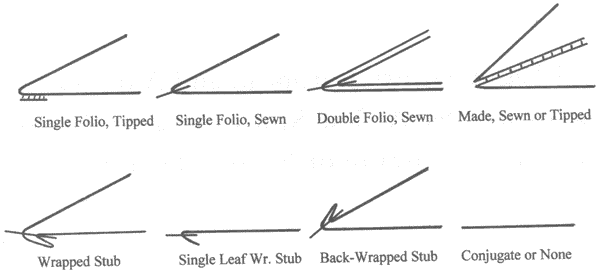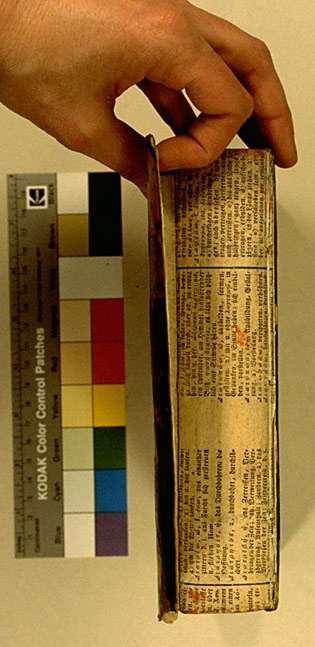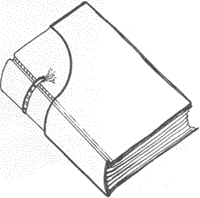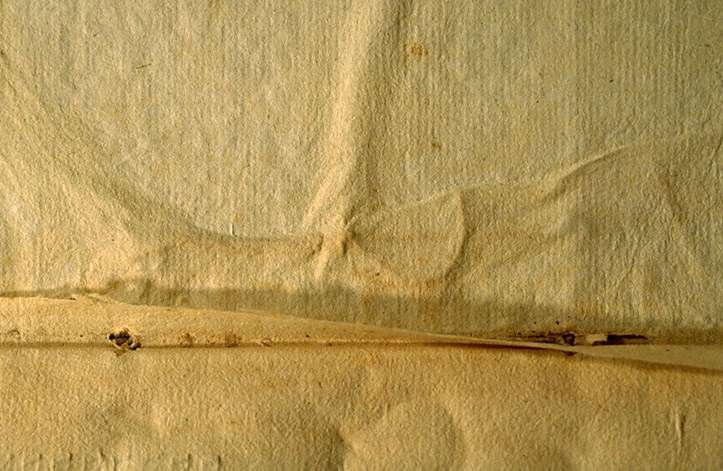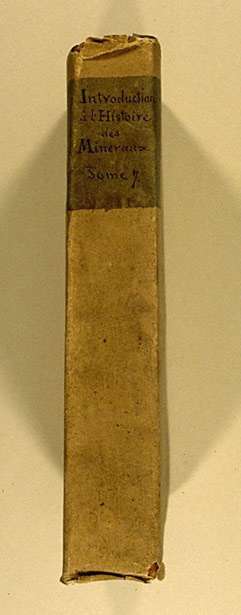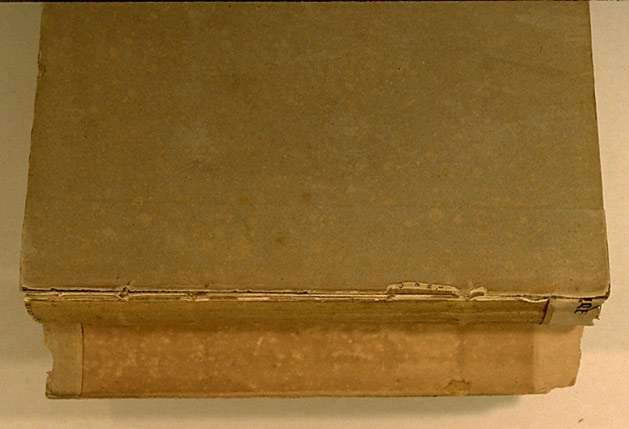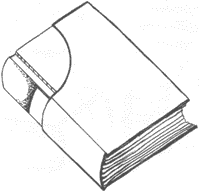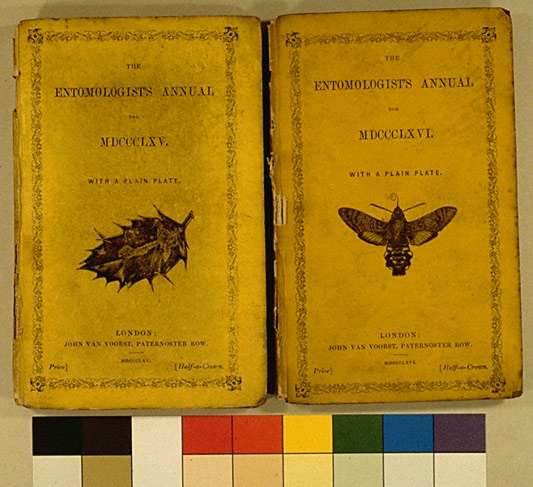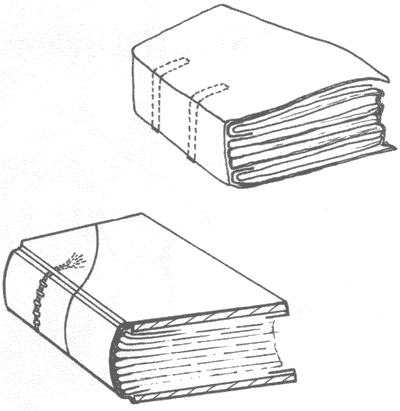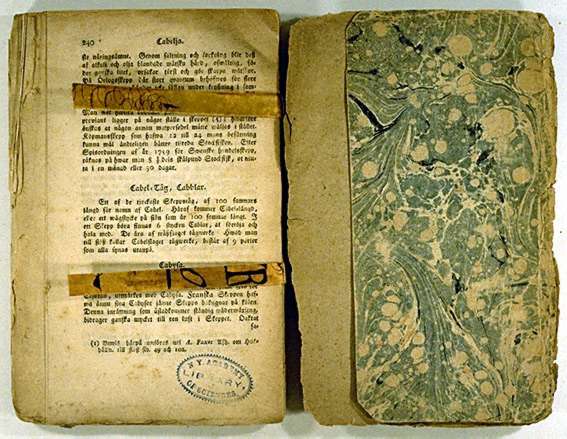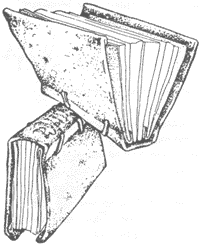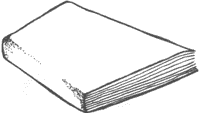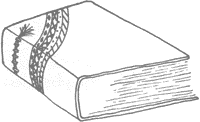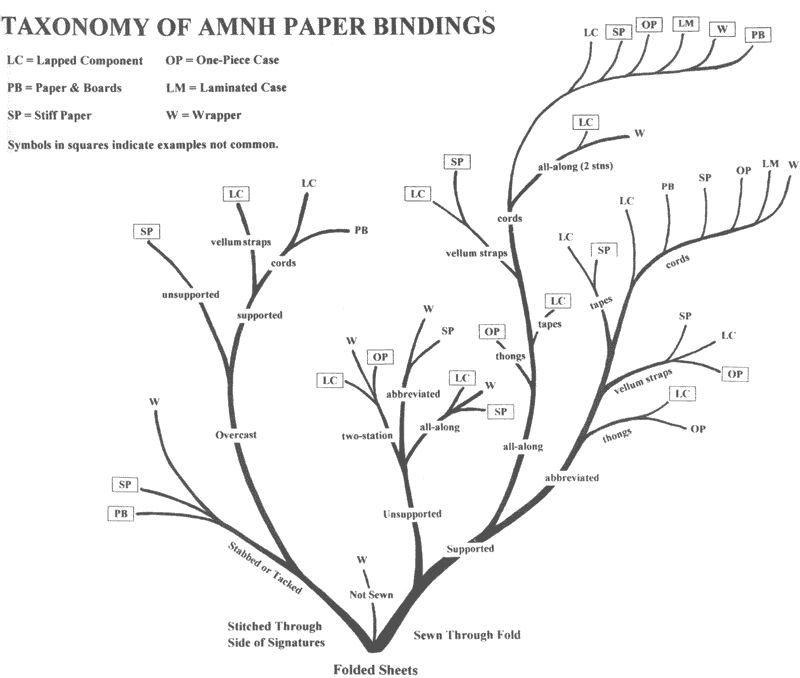18th and 19th Century European and American Paper Binding Structures: A Case Study of Paper Bindings in the American Museum of Natural History Library
by Barbara RhodesIntroduction
The written history of bookbinding has largely been the history of leather and cloth bindings, with emphasis on their decoration. With one or two exceptions, what information on paper bindings is available usually deals with the appearance of the paper covering, or the terminology used to describe it, and provides no documentation of the underlying structures. The utilitarian, the temporary, and the chintzy are largely ignored, which is a shame, because they are much more a part of human life and history than are the deluxe and the fine. Those of us who work with early paper covered books are occasionally frustrated by the lack of specific and detailed historical information about their construction. This paper, then, while it is not a history of paper binding, is a step toward the accumulation of data on the specifics of paper binding - what forms and structures were used, how often, where and when. It will be a look inside the plain brown wrapper, as it were, at the way books in paper bindings are put together.
Over the past several years I have surveyed over 1100 paper bindings in the AMNH Library's collection, most of which were bound in Europe between 1723 and 1889, though isolated earlier volumes have been included. The latter date was selected as the cutoff due to the very small number of available later examples. An updated version of the form used to gather data is reproduced at the end of this article; the form has been adapted to reflect the types of information which I came to recognize as useful during the course of the survey. The main focus of the information gathered can be boiled down to this list: sewing structure; endsheet construction; shaping; edge treatment; spine lining; cover construction; and cover-to-text attachment. Seven distinct types of binding were found, to wit: lapped component; in boards; paper case; stiffened paper; one-piece case; wrapper; and laminated case. Serial publications constitute 36% of the items surveyed. Only whole volumes of paper-bound serials were included, and not single issues, as the history of periodical publication and binding is a topic unto itself. Items with spine strips only were also excluded. All dates cited will be the date of publication of the text, with the caveat that the bindings in some cases may have been added later.
Lapped Component Bindings
Cased Construction
Characteristic Features:
Full forwarding; Boards adhered to heavy piece of paper molded across spine of text; Label usually supplied by binder or printer
Fig. 1. Lapped Component binding characteristics
Lapped component bindings comprise approximately 51% of the surveyed books. I use the term lapped component (coined by Gary Frost) rather than the usual "German trade paper case" or "rigid case," because it describes a discrete type of construction, and because German binders used more than one type of case structure. A lapped component binding is a paper case constructed of boards attached to a piece of heavy paper which is molded over the spine of the textblock as is shown in Figure 1 (Frost also gets credit for this illustration, which is taken from his New Bookbinder article on historical paper bindings 1). They are usually fully forwarded, and in many instances were apparently meant to be the final covering for the book. About 65% of the examples in this category are on German books. Of course, a text need not be bound in the country in which it was published. Other lapped component bindings in the survey were definitely French, Swiss, Italian, or Eastern European, so we can presume that there was at least some overlapping of national binding styles.
About 93% of the books in this category were sewn in an abbreviated pattern on cords, and the remainder "all-along." There were 14 examples sewn on vellum straps (12 German, dated between 1760 and 1818, and two 16th century imprints), 16 on tapes (one 1859 Russian imprint, and 15 German, dated 1813, 1816, then 1859-82) and one 1794 German imprint on leather thongs. Five, from the period between 1861 and 1883, were machine sewn. Some 61 volumes had stab holes visible near the inner margin, indicating a preliminary attachment of the gathered sheets.
Fig. 2. The eight types of endsheet construction found on paper bindings in the AMNH collection
Of the eight types of endsheet construction found overall (see Figure 2), six were used with lapped component bindings. The most common (at 59%) is made by wrapping the folded end of a folio of paper around the outermost sections of the text. The folded end forms a stub between the sections, hence the name "wrapped stub."
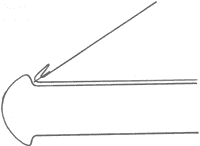
"BACK-WRAPPED MITERED STUB" ENDSHEETS
Fig. 3. Cross section view of the "backed-wrapped mitred stub" endsheet construction
Nearly a quarter of the books had tipped-on single folio endsheets. One type of endsheet with which I was not familiar appeared on 37 books printed between 1765 and 1815 in Germany or Switzerland (Figure 3). I have called it the "back-wrapped mitred stub," but will be glad to hear of a more euphonious name, if an official designation does not already exist. This endsheet is formed by folding the last 3/4 of an inch of a folio towards the outside and sewing through the fold thus created. The corners of the stub are usually trimmed off at an angle. The sewn double folio was used on 32 books, almost all French and German, and all dating from between 1775 and 1829. Single leaf wrapped stub and sewn single folio endsheets were present in small numbers. One 1819 German volume, a rather garish presentation number, had made ends of glazed paper, the stub of which was cut and folded towards the text.
IN-BOARDS BINDING
Fig. 4. Spine linings of printer's waste or other paper are found in 63% of the AMNH Library's lapped component paper bindings
Ninety-four percent of these bindings had been rounded or rounded and backed. Eighty-four percent were ploughed, and a further 5% had been trimmed roughly with scissors or knives. Of the ploughed textblocks, 88% had received some sort of edge coloring. Spine linings were found on books published as early as 1759, and become common by the 1830's. Sixty-three percent of the textblocks in this category had lined spines. (Figure 4) This indicates that spine linings may be much more common in these books than has been previously supposed.
As the 19th century progressed, the appearance of lapped component bindings (and indeed, of all types of paper bindings) became sharper and more polished, but the quality of the materials used deteriorated. Some later bindings were covered in a hard-surfaced paste paper which looks very sophisticated, but hides thin and discolored structural components at the spine. Twenty-five lapped component bindings, mostly dated between 1858 and 1883, had been reinforced at the head and tail with cloth, and one with vellum.
Fifty-five percent of the lapped component bindings had labels of a type probably supplied by the binder, with tooled or stamped glazed paper being the most popular. A small number had leather or printed paper labels.
In Boards Bindings
Laced or laced case construction
Characteristic features:
Cover applied over laced on boards, usually tight to spine; Supported sewing; Rounded or rounded and backed; Edges may be untrimmed, ploughed, or trimmed; Often has printed label.
Fig. 5. In Boards binding characteristics
A little over 15% of the books in the survey were bound in boards (Figure 5). This category of books is actually bound; that is, the covers are built on the textblock, with the sewing supports laced through the boards. A small subcategory of boarded books constructed as laced cases will be described shortly. Binding in boards is generally associated with England and America, but is found on the continent of Europe as well. The Library owns 76 volumes of a turn-of-the-19th-century French set of Buffon's Natural History which are bound in this style, but minimally forwarded. These will be counted as one item for statistical purposes.
All of the books in this category were sewn on cords; the predominant sewing pattern was abbreviated, though about 7% were overcast. Of the overcast volumes, half were English, with large numbers of separate engraved plates, and half were French oversized atlases. Chunks of separate plates overcast together are not uncommon for natural history works. The most common endsheet type on boarded books is the sewn single folio at 37%, followed by the tipped single folio (19%), and then it is fairly evenly distributed amongst sewn double folio, wrapped stub and single leaf wrapped stub, and made ends.
The in-boards bindings surveyed were usually rounded and backed, or at least rounded. Only 5% had not been shaped. Thirty-eight percent had lined spines. Fifty-five percent of the books which were bound in this style had untrimmed edges, and 28% were ploughed. The remainder were trimmed or partially trimmed.
Fig. 6. Detail of the two thin cords laced through and tied inside the board of one volume of a turn-of-the-19th-century set of Buffon's Histoire Naturelle
Fig. 7. Typical paper jacket found on boarded volumes of Buffon's Histoire Naturelle
The large set of Buffon's Natural History mentioned earlier has some interesting peculiarities. The Library owns 111 volumes of this set in all, a few of which are duplicates. Seventy-six volumes are in boards, and 35 in wrappers. The latter are mostly on the subject of insects; apparently the owner was not very interested in this facet of natural history, and was unwilling to go to the expense of binding those volumes in boards. The boarded books are sewn on two very thin cords in a conventional two-on pattern, then the cords are laced through and tied together on the inside of the board (see Figure 6). Each of these volumes has a book jacket made of heavy paper (Figure 7), with a handwritten label on blue paper. These are an unusual feature for ephemeral bindings, and are unlikely to have been supplied by the binder unless by special request.
Laced Cases
Fig. 8. Interior view of the spine of an 1830's English laced case binding
Some 22 items had laced case bindings. The boards were laced on, as you can see in this example from an 11 volume English botanical set from the 1830's (Figure 8). The paper cover incorporates a spine inlay as wide as the spine of the book, and the turn-ins are folded over it. Another (two-volume) set of English laced cases from 1821 was put together a bit more crudely, without shaping, trimming, or lining. This structure was used on volumes up to 57 cm. in height (the largest was an 1812 French atlas); most examples of this type of binding had not withstood use very well. However, one French set from 1834 was quite sturdily made. The boards were laced on, and a wide strip of vellum with a paper spine inlay was adhered to the boards and turned in at the head and tail. The embossed glazed paper cover was applied over this structure.
Paper Cases
PAPER CASE BINDING
Cased construction.
Characteristic features:
Case has spine inlay which is width of book spine; Supported sewing on cords, which are trimmed off at edge of spine; Usually ploughed, spine lined; Rounded or rounded and backed.
Fig. 9. Paper Case binding characteristics
Paper cases are made off the book, and are constructed very much like modern cloth cases, with the cover turned in over the boards and spine inlay (see Figure 9). Cover-to-text attachment is achieved by pasting the endsheets to the boards. There were 39 books (3.5% of the total) in paper cases included in the survey; 15 of which were part of an English serial. About half of the paper cases were from England, but there were several each from Switzerland, France, America, the Netherlands, Germany, and Russia as well. Forwarding for the paper cased books was much the same as for the in-boards category, but a higher percentage of them were not shaped, and a much higher number (90%) had been ploughed. All but two of the bindings in this category were sewn supported on cords, and 92% were sewn in an abbreviated pattern.
Fig. 10. The 1865 and 1866 volumes of the Entomologists' Annual, in paper cases
The Entomologist's Annual from 1855 to 1874 was covered in yellow printed paper featuring a depiction of what was presumably the bug of the year on the front cover (Figure 10). Nine volumes, beginning in 1865, are lined with mull. Besides these examples, only three more paper cased books had mull linings, two from England in 1867 and 1879, and one American book from 1888. The earliest and only other mull lining found was on an English boarded book from 1860.
Stiffened Paper Bindings
STIFFENED PAPER BINDING
Tight-to-spine construction
Characteristic features:
Sewn on cords or vellum straps; Textblock unshaped or rounded; Thin boards adhered to endsheets and covered with paper, which turns in at foredge; May be plouged after covering.
Fig. 11. Stiffened Paper binding characteristics
Fig. 12. The back cover of this 1792 Swedish imprint once folded in over the long vellum slips
Stiffened paper bindings represent about 9% of the bindings surveyed (Figure 11). They are basically beefed-up wrappers with thin board or thick paper supports. The endsheets are adhered to the boards, with the sewing supports, if any, sandwiched between. In the typical mid-19th century German version, the textblock is rounded, the boards are cut flush with the head and tail, and the outer covering of paper ploughed off with them. The cover paper is turned in at the foredge of the board, which extends beyond the edge of the text. This sort binding could hold its own on a shelf; other versions are less sturdy. Many are unshaped and untrimmed, with only pieces of heavy paper for cover stiffeners. This 1792 Swedish imprint (Figure 12) has an idiosyncratic stiffened cover, which apparently once folded in at the back over the extremely long slips of vellum. The front cover has short slips of vellum visible beneath the endsheet; if it once folded over like the back cover (which I suspect it did not), the "flap" is unfortunately missing.
Seventy-five percent of these bindings were sewn on cords and 11% on vellum straps, and again, the predominant sewing pattern used was an abbreviated one. The most common endsheets were wrapped stubs and single leaf wrapped stubs at 32% each. Sewn single folio ends accounted for 13% and tipped single folios for a further 15%. The remainder of the volumes had no endsheets. Most of the books in this category (60%) had not been shaped; the rest were rounded. Twenty percent had been trimmed, but the majority (53%) had been ploughed on one or more edges.
One-Piece Cases
ONE-PIECE CASE
Laced case construction
Characteristic features:
Cover constructed off the book, from single piece of heavy paper, folded and creased to fit textblock; Sewn on tawed thongs, cords, or vellum straps, which are laced through the cover; Not shaped; Edges not trimmed.
Fig. 13. One Piece Case binding characteristics
The one-piece case (or limp paper case) is the stereotypical early Italian paper binding, and is usually associated with small books (see Figure 13, also appropriated from Gary Frost). The cases are constructed off the book, from a single piece of heavy paper which is folded and creased to fit around the textblock. The text is typically sewn on alum tawed thongs, which are laced through the cover; the endsheets are generally of the wrapped stub variety, and may or may not be pasted down. The textblocks are not shaped, lined, or trimmed. The AMNH Library only owns 10 one-piece case bindings, two of which are anomalous, so the data may not be statistically significant, but the bindings have some interesting features nonetheless.
The earliest binding of this type in our collection is of a French text from 1645. It has all the typical features of cover, endsheets, sewing, and cover to text attachment. The same may not be said for the 1674 binding of a German text; it is sewn on cords, which are not laced through. The other 8 one-piece cases are on Italian books, published between 1684 and 1793. Three of them, a set from the 1780's, are folios over 46 centimeters (so much for small books); the others are large octavo to small quarto size, and are unremarkable except that one volume of an Italian serial published in 1793 had decorative paper applied over its spine. The one real oddball in the group is a bogus one-piece case on a 1766 Italian text, which is sewn on cords, but has three non-structural leather thongs laced through the case.
Wrappers
WRAPPERS
Tight-to-spine construction
Characteristic features:
Limp paper cover which may be lined, and may be adhered to endsheets or to spine only; May have supported sewing, unsupported, or no sewing; Not shaped or lined; Edges may be untrimmed, ploughed, or cut on one or two edges.
Fig. 14. Wrapper characteristics
Wrappers constitute 20% of the bindings in the survey (Figure 14). As I have a chance to go through the 30,000 items in pamphlet binders in our collection, more will undoubtedly turn up. They are the least complex structures to be considered here, but there were a surprising number of variations.
TWO-STATION UNSUPPORTED SEWING
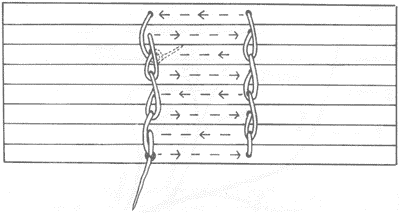
Fig. 15. This two-station form of linked abbreviated sewing was the pattern most commonly found on smaller books in wrappers
While the great majority (85%) of the books in wrappers were sewn unsupported, 31 items were sewn on cords. These were mainly, but not exclusively, from England. For smaller books, the form of linked abbreviated sewing using only two stations which is shown in Figure 15 predominated. It is rather like sewing using only kettle stitches. In the Buffon set of 35 wrappered volumes as well as others of French origin such as this one from 1865, the thread exits from the final station and is brought back down into the third section, where it is looped around the thread in the fold and tied off. The stitches in some later books were no more than half an inch long. One volume was sewn at two stations only, using a chain stitch. Some larger books had a different version of linked abbreviated sewing, and very thin ones might be sewn in several ways. Single section items could be sewn through the fold in a butterfly stitch, but more often thin books were stitched through the sides of the signatures. About 9% of those surveyed had been stab sewn, and 7% were tacked. Four books were held together only by knife slits or shallow saw kerfs which were filled in by glue. One 1856 item was uncut, and was secured only by gluing the backs of the sections together.
Of those with supported sewing, most were sewn in an abbreviated pattern, but a set of 9 volumes of the Synopsis of the Contents of the British Museum, published between 1845 and 1855, and one Swedish volume from 1883 were sewn on two cords with no kettles. Ninety-nine percent of the books in wrappers were not shaped; a few showed signs of rounding. Twenty-seven percent were ploughed or partially ploughed, and 8% were trimmed or partially trimmed.
Many wrappers, particularly the later ones, consist of a single piece of paper adhered only to the spine of the book or pamphlet. Earlier ones are likely to be lined or partially lined with another sheet of paper, and pasted to the endsheets of the book. A large majority (61%) of the wrappered items surveyed did not have endsheets; 7% were conjugate with the text. The most common type of endsheet construction was the single leaf wrapped stub at 27%. Five books had sewn single folio ends; three of these were American, from the 1830's, one German from 1820, and one French, from 1857.
Laminated Cases
LAMINATED CASE
Cased construction
Characteristic features:
Cover made of pieces of paper, often waste, pasted and pressed together; Not shaped; Edges trimmed or ploughed.
Fig. 16. Laminated Case characteristics
"Laminated case" is a term I had to invent, as I have not seen a case like this described in print. The Library has four examples of this type, all constructed slightly differently. For example, the case for this 1785 German imprint (Figure 16) was constructed of layers of heavy plain paper covered with an elaborate paste paper. This was adhered to the endsheets, forming the most basic of case structures. The textblock itself is a bit unusual, being ploughed and colored on the edges, but not shaped; it also has back-wrapped stub endsheets. One 1748 case (also German) was put together with layers of blue and plain paper used as stiffeners for the sides of the case, and three layers of paper over the center section to strengthen the spine. These three layers and the cover paper were slit to the height of the book at the head and tail, and turned in over the endsheets, to which the case was first pasted.
Conclusion
Fig. 17. The relationships of the various "species" of paper binding, based on their sewing patterns
I must say that I was mildly surprised by the variety of paper binding structures and their permutations. As an exercise, I drew this phylogenetic tree based on their sewing patterns and supports (Figure 17). In-boards and paper case bindings had very similar sewing structures, and are lumped together here as "paper & boards" for economy of space. I am not suggesting this as a model for general use, but it does show some of the underlying interrelationships between the various "species" of paper binding.
I do have one serious suggestion to make, which is that one or two of the structures discussed here might serve as examples for conservation rebinding, alongside the one-piece case and lapped component models already in use. The 1834 French vellum reinforced laced cases had held up remarkably well, and for small unshaped texts, a version of the laminated case using heavy handmade paper might provide sufficient protection in proper storage conditions. I would also like to experiment with back-wrapped stub endsheets, which appear to have the advantages of a sewn double folio without the bulk.
In conclusion, I urge all book conservators to examine and record the structures of any early paper bindings in their institution's collections if at all possible. Not only will these "vanishing species" thus be documented before extinction, but the more closely we look at what we have, the more likely we are to find something we can use.
| Date | Country of Publ. | Call No. | ||
| Author | Printer | |||
| Title | Imprint | |||
| Endsheets: | intact() repaired() contemporary w/text( )not contemporary()date inscr.( ) no ends( ) wrapped stub() single leaf wrapped stub( )back-wrapped mitred stub() tipped single folio() sewn single folio() sewn double folio() made, sewn () made, tipped() conjugate w/ text() other |
| Sewing: | intact() original() resewn() supported() no. of supports() unsupported() pattern: all-along() abbreviated() two-station() overcast() stab sewn() tacked() butterfly() machine sewn() not sewn() supports: cords() tapes() vellum straps() tawed thongs() leather thongs() |
| Textblock: | intact() repaired() dimensions in cm.: ht( ) wd() th() adhesive: glue() paste() none() spine lined() lining trimmed() brought over shoulder() shaping: rounded & backed() rounded() not shaped() edges: untrimmed() trimmed() part trimmed( ) ploughed() part ploughed() colored() sprinkled() color ____________________ gilt() |
| Cover: | intact() repaired() dimensions in cm.: ht( ) wd() th() cover/text attachment: intact() repaired() type: lapped component() inboards() paper case() stiffened paper( ) wrapper() one-piece case() laminated case() construction: case() laced() laced case() tight-to spine() reinforced: head & tail() spine() corners() reinforced w/vellum() reinforced. w/cloth() reinforced w/paper() |
| Materials: | boards: pasteboard() millboard() strawboard( ) overcover: colored paper() glazed paper() marbled paper() printed paper() pastepaper() color pieced__________ () |
| Finishing: | intact() none() missing() trace() obscured() handwritten in ink() label: on spine( )onboard() tooled glazed paper() stamped glazed paper() primed paper() leather() handwritten() other() decoration: gilt tooling on spine() gilt tooling on board( ) volume label() owner's shelf label() endbands() trimmed to spine width( ) brought over shoulder( )type __________ ribbon marker()__________ color |
| Evidence of Secondary Binding: stab holes() unused saw kerfs() wrapper covers bound in() remnants of colored paper along spine folds() | |
| Observations: | |
Notes
1. Frost, Gary. "Historical Paper Case Binding and Conservation Rebinding." The New Bookbinder, 2 (1982) p. 64-67. The illustration of one-piece cases is also taken from this article. All other drawings presented here were done by Paula Schrynemakers.
Barbara RhodesConservator,Department of Library Services
American Museum of Natural History Library
Publication History
Received: Fall 1995
Paper delivered at the Book and Paper specialty group session, AIC 23th Annual Meeting, June 4-1, 1995, St. Paul, Minnesota.
Papers for the specialty group session are selected by committee, based on abstracts and there has been no further peer review. Papers are received by the compiler in the Fall following the meeting and the author is welcome to make revisions, minor or major.

